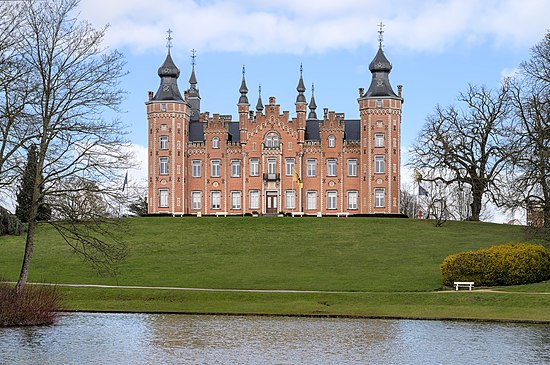Wikipedia:Main Page alternatives/(simple layout)
Almanac · Categories · Glossaries · Lists · Overviews · Portals · Questions · Site news · Index
Art | Geography | History | Mathematics | People | Philosophy | Science | Society | Technology
We are building an open-content encyclopedia in many languages. We started in January 2001 and are now working on 6,825,974 articles in the English version. Learn how to edit pages, experiment in the sandbox, and visit our Community Portal to find out how you can contribute to Wikipedia. This page is also available without pictures. More main page alternatives
Today's featured article
The oyster dress is a high fashion gown created by British fashion designer Alexander McQueen for his Spring/Summer 2003 collection Irere. McQueen's design is a one-shouldered dress in bias-cut beige silk chiffon with a boned upper body and a full-length skirt consisting of hundreds of individual circles of organza sewn in dense layers to the base fabric, resembling an oyster shell. The dress originated as a reinterpretation of the "shellfish dress" designed by John Galliano in 1987, which McQueen had long admired and sought to emulate. Contemporary critical responses to McQueen's oyster dress were positive and it is considered an iconic piece of McQueen's work. Only two copies are known to exist, one held by the Metropolitan Museum of Art in New York City and one by media personality Kim Kardashian. McQueen returned to the oyster dress concept several times over his career, most prominently in his Autumn/Winter 2006 collection The Widows of Culloden. (Full article...)
Did you know...

- ... that bears may be dispersers of the Japanese mountain cherry (painting pictured)?
- ... that Romani Holocaust survivor Philomena Franz wrote about her deportation to Auschwitz, internment in Ravensbrück, escape from a camp near Wittenberge, and concealment by a farmer?
- ... that a large basin on Neptune's moon Triton may have once been filled with liquid water cryolava, similar to how liquid silicates fill lava lakes on Earth?
- ... that Inman Jackson played "as though he were born with a basketball in each hand"?
- ... that Josephine Kenyon moved from recommendations of rigid scheduling to "on-demand" scheduling in editions of her book Healthy Babies Are Happy Babies?
- ... that Amie Parnes allegedly first heard about her employer, The Messenger, ceasing operations from a New York Times article?
- ... that Coffee Talk Episode 2: Hibiscus & Butterfly was released after the main creator of Coffee Talk died in March 2022?
- ... that baritone Liviu Holender chose lieder by five composers whose music was banned by the Nazis—Schreker, Zemlinsky, Mahler, Korngold and Schönberg—for a recital at the Oper Frankfurt?
- ... that some members of the U.S. Army Air Corps were so unimpressed by the Estoppey D-8 that one member stated that he would rather use "nails and a wire"?
In the news
- A helicopter crash near Varzaqan, Iran, kills eight people, including President Ebrahim Raisi (pictured) and Foreign Minister Hossein Amir-Abdollahian.
- In boxing, Oleksandr Usyk defeats Tyson Fury to become the first undisputed heavyweight champion in twenty-four years.
- Protests over voting rights changes break out in the French territory of New Caledonia.
- Lee Hsien Loong steps down after nearly twenty years as Prime Minister of Singapore, and is succeeded by Lawrence Wong.
On this day
- 1766 – A magnitude-7.1 earthquake struck Constantinople and was followed by a tsunami that caused significant damage.
- 1874 – Giuseppe Verdi's Requiem was first performed in the San Marco church in Milan to commemorate the first anniversary of Alessandro Manzoni's death.
- 1998 – In Public Prosecutor v Taw Cheng Kong, the Court of Appeal of Singapore overruled a High Court decision in the only time a statute in Singapore had been ruled unconstitutional.
- 2014 – Prayut Chan-o-cha (pictured), the commander-in-chief of the Royal Thai Army, launched a coup d'état against the caretaker government following six months of political crisis.
- Jovan Vladimir (d. 1016)
- John Forest (d. 1538)
- Charles Aznavour (b. 1924)
- Apolo Ohno (b. 1982)
Today's featured picture

|
|
De Viron Castle is a castle in the town of Dilbeek in Flemish Brabant, Belgium. Commissioned by the de Viron family, which settled in Dilbeek in 1775, the castle was built in 1863 by Jean-Pierre Cluysenaar. The Renaissance Revival castle was built on the ruins of a 14th-century fortification that was destroyed in 1862. One of the medieval towers, the Sint-Alenatoren, can still be seen in the park surrounding the current building and is named after Saint Alena, who lived in Dilbeek. The castle has served as the town hall of Dilbeek and housed the offices of the municipality since 1923, and was listed as a Belgian protected monument in 1990. This photograph shows the facade of De Viron Castle with the surrounding park in the foreground. Photograph credit: Benoit Brummer
Recently featured:
|
Portals
Categories
Culture
Arts – Culture by region – Languages – Literature – Mass media – Movements – Mythology – Popular culture – Religion – Sports – Traditions – Travel
Entertainment
Animation – Celebrities – Dance – Entertainers – Festivals – Games – Hobbies – Humour – Music – Parties – Radio – Television – Toys
Geography
Africa –
Antarctica –
Asia –
Australia –
Europe –
North America –
Oceania –
South America
Cities –
Climate –
Countries –
Landforms –
Maps –
Parks –
Subterranea –
Towns
History
Mathematics and Abstractions
Algebra – Analysis – Arithmetic – Computer science – Economics – Equations – Geometry – Logic – Measurement – Numbers – Proofs – Philosophy – Theorems – Trigonometry – Statistics
Personal life
Science and Nature
Astronomy – Biology – Chemistry – Earth sciences – Ecology – Information science – Natural hazards – Neuroscience – Physics – Space
Social sciences and Society
Anthropology – Archaeology – Business – Communication – Demographics – Economics – Finance – Government – History – Law – Linguistics – Philosophy – Politics – Psychology – Sociology – Sexology
Technology
Agriculture – Architecture – Computing – Electronics – Engineering – Manufacturing – Medicine – Nuclear technology – Telecommunications – Tools – Transport – Vehicles
Reference
Sister Projects
Wikipedia is run by the non-profit Wikimedia Foundation. Wikimedia operates several other multilingual and open-content wiki projects:
Meta-Wiki — Coordination of all Wikimedia projects
Wiktionary — A multilingual dictionary and thesaurus
Wikibooks — Free textbooks and manuals
Wikiquote — A collection of quotations
Wikisource — Free source documents
Wikinews — Free content news source
Wikipedia in other languages
This Wikipedia is written in English. Many other Wikipedias are available; some of the largest are listed below.
-
1,000,000+ articles
-
250,000+ articles
-
50,000+ articles
If you find this encyclopedia or its sister projects useful, please consider making a donation.


